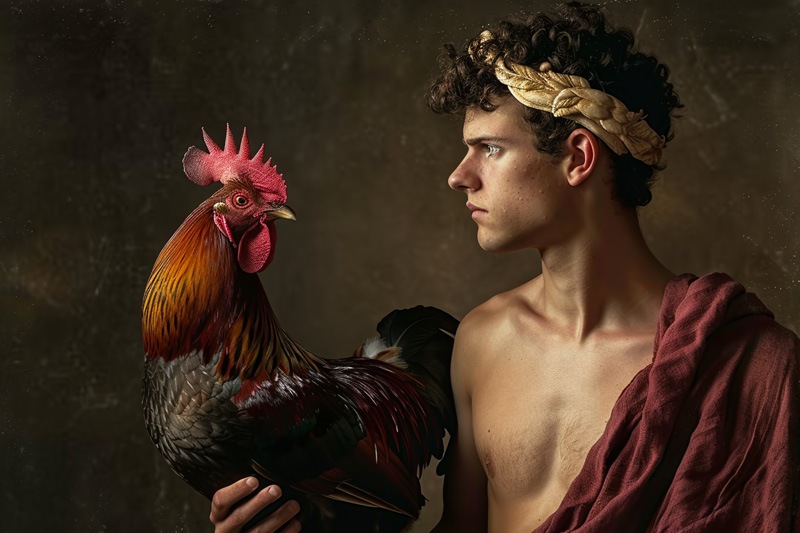KidZone Geography: Greek Mythology
About Hermes, God of Trade and Communication
Introduction to Hermes
Hermes, one of the twelve Olympian deities in Greek mythology, is the god of trade, communication, travel, and thievery. Known for his speed and cunning, Hermes is often depicted with winged sandals and a caduceus (a staff entwined with two serpents). He serves as the messenger of the gods and a guide to the underworld, embodying versatility and adaptability.

Quick Facts About Hermes
What is Hermes the Greek god of?
Hermes is the Greek god of trade, communication, travel, thievery, and athletics. He is also the messenger of the gods and a guide for souls to the underworld.
What are Hermes's sacred animals?
Hermes's sacred animals include the tortoise and the rooster. The tortoise symbolizes protection and perseverance, while the rooster represents vigilance and new beginnings.

What are Hermes's symbols?
Hermes's primary symbols are the caduceus, the winged sandals, and the petasos (a wide-brimmed hat). The caduceus represents commerce and negotiation, the winged sandals signify speed and mobility, and the petasos denotes travel and exploration.
Origins and Birth
Birth in Arcadia
Hermes was born to Zeus and the nymph Maia in a cave in Arcadia. From birth, he exhibited remarkable talents and cunning. On the very day he was born, Hermes invented the lyre using a tortoise shell and later stole Apollo's cattle, showcasing his cleverness and versatility.
Hermes's Role in Greek Mythology
Messenger of the Gods
Hermes's primary role is as the messenger of the gods. He is responsible for delivering messages between the divine and mortal realms. His speed and agility enable him to travel swiftly, and he is often depicted carrying the caduceus as a symbol of his diplomatic abilities.
Guide of Souls
Hermes is also the psychopomp, a guide for souls to the underworld. He leads the deceased to Hades, ensuring they reach their final resting place. This role underscores his connection to both life and death, as well as his ability to navigate different realms.
Iconography and Symbols
The Caduceus
The caduceus, a staff entwined with two serpents, is Hermes's most recognizable symbol. It represents his role in commerce, negotiation, and communication.
The Winged Sandals

The winged sandals, known as talaria, symbolize Hermes's speed and ability to move freely between worlds. They are often depicted in art and literature, emphasizing his mobility and swiftness.
The Petasos
The petasos, a wide-brimmed hat, is associated with travel and exploration. It signifies Hermes's role as the protector of travelers and his connection to journeys and trade.
Major Myths Involving Hermes
The Theft of Apollo's Cattle
One of the most famous myths involving Hermes is his theft of Apollo's cattle. As a newborn, Hermes stole the cattle and cleverly disguised his tracks. When confronted by Apollo, Hermes returned the cattle and gifted him the lyre, establishing a bond between the two gods.
The Role in the Odyssey
Hermes plays a crucial role in Homer's "Odyssey," where he aids Odysseus. He provides Odysseus with the herb moly to protect him from Circe's magic and later convinces Calypso to release Odysseus from her island, demonstrating his influence and resourcefulness.
The Slaying of Argus
Hermes is known for slaying the giant Argus, who had a hundred eyes and was tasked by Hera to watch over Io. Hermes lulled Argus to sleep with his music and then killed him, freeing Io. This act earned Hermes the epithet "Argeiphontes," meaning "slayer of Argus."
Hermes's Relationships and Offspring

Relationships with Mortals and Deities
Hermes had numerous relationships with both mortals and deities, resulting in many offspring. His charm and wit made him a favored companion of many gods and mortals alike.
Divine and Mortal Offspring
Hermes's children played significant roles in various myths and legends. Some of his notable offspring include:
- Pan: The god of the wild, shepherds, and flocks, known for his rustic music and connection to nature.
- Hermaphroditus: A deity of both sexes, embodying the union of male and female attributes.
- Autolycus: A renowned thief and trickster, known for his cunning and ability to evade capture.
Worship and Cult of Hermes
Temples and Sanctuaries
Hermes was worshipped throughout ancient Greece, with many temples and sanctuaries dedicated to him. The most notable of these include the Temple of Hermes at Pharae and the Hermaion at Tanagra. These sites served as centers for worship and commerce, reflecting Hermes's role in trade and communication.
Festivals and Rituals
Several festivals celebrated Hermes's influence over trade, travel, and communication. The most notable of these include:
- The Hermaea: Festivals held in various Greek cities, featuring athletic competitions and sacrifices in Hermes's honor.
- The Anthesteria: A festival in Athens where Hermes was invoked as a psychopomp to aid in rituals honoring the dead.
Hermes in Art and Literature

Classical Depictions
In classical art, Hermes is often depicted as a youthful figure with winged sandals and a caduceus. These representations emphasize his speed, agility, and role as a messenger.
Renaissance and Beyond
During the Renaissance, artists like Botticelli and Raphael drew inspiration from classical depictions of Hermes. These works often portrayed him as a dynamic and graceful figure, reflecting his versatility and influence.
Modern Interpretations
In modern times, Hermes continues to be a prominent figure in literature, film, and popular culture. He appears in various forms, from comic books and movies to television series and video games. These contemporary portrayals often explore different aspects of his character, from his cleverness and wit to his role as a guide and protector. In the Percy Jackson series, for example, Hermes is depicted as a witty and resourceful god, reflecting modern interpretations of his myth.
Conclusion
Hermes remains one of the most versatile and dynamic figures in Greek mythology. His roles as the god of trade, communication, travel, and thievery, combined with his complex personality and significant myths, make him a fascinating character. As the messenger of the gods and a guide for souls, Hermes's influence extends across the divine and mortal realms. His enduring impact can be seen in the continued fascination with his myths and the artistic representations that keep his legend alive. Through his worship, iconography, and the rich tapestry of stories that surround him, Hermes exemplifies the adaptability and ingenuity of ancient Greek religion and mythology.